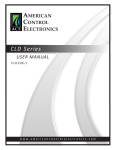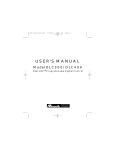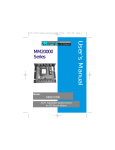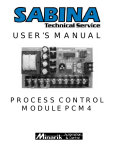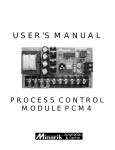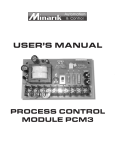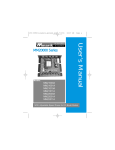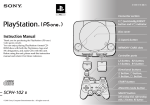Download USER`S MANUAL - Minarik Drives
Transcript
250-0258 rev 1.qxd 4/14/99 1:49 PM Page I USER’S MANUAL Model DLC500 DIGI-LOK® Programmable Digital Control 250-0258 rev 1.qxd 4/14/99 1:49 PM Page II Copyright 1998 by Minarik Corporation All rights reserved. No part of this manual may be reproduced or transmitted in any form without written permission from Minarik Corporation. The information and technical data in this manual are subject to change without notice. Minarik Corporation and its Divisions make no warranty of any kind with respect to this material, including, but not limited to, the implied warranties of its merchantability and fitness for a given purpose. Minarik Corporation and its Divisions assume no responsibility for any errors that may appear in this manual and make no commitment to update or to keep current the information in this manual. Printed in the United States of America. 250-0258 rev 1.qxd 4/14/99 1:49 PM Page i m Safety Warnings • Have a qualified electrical maintenance technician install, adjust, and service this equipment. Follow the National Electrical Code and all other applicable electrical and safety codes, including the provisions of the Occupational Safety and Health Act (OSHA) when installing equipment. • Reduce the chance of an electrical fire, shock, or explosion by proper grounding, over current protection, thermal protection, and enclosure. Follow sound maintenance procedures. • The control is not isolated from earth ground. Circuit potentials are at 115 VAC or 230 VAC above earth ground. Avoid direct contact with the printed circuit board or with circuit elements to prevent the risk of serious injury or fatality. Use a non-metallic screwdriver for adjusting switch settings. 250-0258 rev 1.qxd 4/14/99 1:49 PM Page ii ii Contents Introduction 1 Specifications 3 Dimensions 5 Installation 7 Mounting . . . . . . . . . . . . . . . . . . . . . . . . . . . . . . . . . . . . . . . . . . . . . . . . . .7 Wiring guidelines . . . . . . . . . . . . . . . . . . . . . . . . . . . . . . . . . . . . . . . . . . . .8 Drive compatibility . . . . . . . . . . . . . . . . . . . . . . . . . . . . . . . . . . . . . . . . . . . .9 Panel installation . . . . . . . . . . . . . . . . . . . . . . . . . . . . . . . . . . . . . . . . . . . .10 Feedback device selection . . . . . . . . . . . . . . . . . . . . . . . . . . . . . . . . . . . .14 Rear panel selector and DIP switches . . . . . . . . . . . . . . . . . . . . . . . . . . . .15 Connections . . . . . . . . . . . . . . . . . . . . . . . . . . . . . . . . . . . . . . . . . . . . . . .17 Terminal description . . . . . . . . . . . . . . . . . . . . . . . . . . . . . . . . . . . . . . . . .17 Output terminal connections to regenerative drives . . . . . . . . . . . . . . . . . .17 Output terminal connections to XP-AC series drives . . . . . . . . . . . . . . . . .18 Calibration 21 Drive calibration . . . . . . . . . . . . . . . . . . . . . . . . . . . . . . . . . . . . . . . . . . . .22 DLC500 calibration . . . . . . . . . . . . . . . . . . . . . . . . . . . . . . . . . . . . . . . . . .22 Programming 25 Program parameters . . . . . . . . . . . . . . . . . . . . . . . . . . . . . . . . . . . . . . . . .25 Speed scaling factor . . . . . . . . . . . . . . . . . . . . . . . . . . . . . . . . . . . .25 Load response number . . . . . . . . . . . . . . . . . . . . . . . . . . . . . . . . . .26 Display scaling factor . . . . . . . . . . . . . . . . . . . . . . . . . . . . . . . . . . . .26 Gate time . . . . . . . . . . . . . . . . . . . . . . . . . . . . . . . . . . . . . . . . . . . . .27 Decimal point location number . . . . . . . . . . . . . . . . . . . . . . . . . . . . .27 250-0258 rev 1.qxd 4/14/99 1:49 PM Page iii iii DLC500 program parameters worksheet . . . . . . . . . . . . . . . . . . . . . . . . . .28 Entering the programming mode . . . . . . . . . . . . . . . . . . . . . . . . . . . . . . . .29 Viewing the programming screens . . . . . . . . . . . . . . . . . . . . . . . . . . . . . .29 Entering calculated program parameters . . . . . . . . . . . . . . . . . . . . . . . . . .30 Save the program settings and exit to the operation mode . . . . . . . . . . . .31 Entering the operation mode . . . . . . . . . . . . . . . . . . . . . . . . . . . . . . . . . . .31 Set the speed . . . . . . . . . . . . . . . . . . . . . . . . . . . . . . . . . . . . . . . . . . . . . .32 Programming Examples 35 Troubleshooting 41 Unconditional Warranty inside back cover 250-0258 rev 1.qxd 4/14/99 1:49 PM Page iv 250-0258 rev 1.qxd 4/14/99 1:49 PM Page 1 Introduction Minarik’s DLC500 control is used with variable speed drives to produce closed-loop digital systems capable of controlling motor speed precisely and with excellent reproducibility. The DLC500 includes these benefits: Excellent speed regulation: 0.05% speed regulation of set speed for tight control. Pushbutton programming: Quick and easy programming using three front panel pushbuttons. 4-digit LED display: 0.5 inch (13 mm) wide digits are easily readable. Programmable decimal point: Great for specific application readouts. Selectable feedback devices: Controls accept magnetic pickup, hall effect, inductive proximity sensor or encoder input. +5 VDC or +12 VDC (10 mA) power supply for feedback devices: Additional power supply is unnecessary. Removable screw-terminal block: Easy terminal block connections. 250-0258 rev 1.qxd 2 4/14/99 1:49 PM Page 2 250-0258 rev 1.qxd 4/14/99 1:49 PM Page 3 3 Specifications AC Line Voltage 115 VAC or 230 VAC, ±10%, 50/60 Hz, single phase AC Line Power 5.5 watts nominally Acceptable Feedback Sources 5 VDC or 12 VDC NPN-type encoder 5 VDC or 12 VDC NPN-type proximity switch Hall effect sensor Electromagnetic pickup Maximum Reference Voltage of Drive Power Supply Voltage for Feedback Devices Speed Regulation Feedback Frequency Range Ambient Operating Temperature Range Weight +10 VDC +5 VDC or +12 VDC 0.05% 200:1 10°C–40°C approximately 1 lb 250-0258 rev 1.qxd 4 4/14/99 1:49 PM Page 4 250-0258 rev 1.qxd 4/14/99 1:49 PM Page 5 5 Dimensions Figure 1. DLC500 Dimensions 250-0258 rev 1.qxd 6 4/14/99 1:49 PM Page 6 250-0258 rev 1.qxd 4/14/99 1:49 PM Page 7 7 Installation Mounting Protect the control from dirt, moisture, and accidental contact. Provide sufficient room for access to the terminal block and calibration trimpots. Mount the control away from other heat sources. Operate the drive within the specified ambient operating temperature range. Prevent loose connections by avoiding excessive vibration of the control. m Caution Variable speed DC drives manufactured by other companies may require hookup procedures that differ from those given in this manual. Contact your local Minarik branch or distributor for assistance. A schematic diagram and the manufacturer’s instruction for interfacing the drive with an external speed-setting signal may be required before the correct wiring scheme can be determined. 250-0258 rev 1.qxd 8 4/14/99 1:49 PM Page 8 Installation Wiring Shielding guidelines As a general rule, Minarik recommends shielding of all conductors if: 1) wire lengths exceed 18 inches, with separation of power and logic leads; 2) wire lengths exceed 4 inches and power and logic leads must be bundled together*; 3) radiated and/or conducted noise must be minimized due to concerns about immunity or general compliance (CE, FCC, etc.) *Minarik considers this an unfavorable condition and does not recommend bundling of power and logic leads for any length. m If it is not practical to shield power conductors, Minarik recommends shielding all logic-level leads. If shielding is not practical, the user should twist all logic leads with themselves to minimize induced noise. m ( Under no circumstances should power and logic leads be bundled together. Induced voltage can cause unpredictable behavior any electronic device, including motor controls. 250-0258 rev 1.qxd 4/14/99 1:49 PM Page 9 Installation 9 It may be necessary to earth ground the shielded cable. If noise is produced by devices other than the drive, ground the shield at the drive end. If noise is generated by a device on the drive, ground the shield at the end away from the drive. Do not ground both ends of the shield. If the drive continues to pick up noise after grounding the shield, it may be necessary to add AC line filtering devices, or to mount the drive in a less noisy environment. Do not disconnect any of the motor leads from the drive unless power is removed or the drive is disabled. Opening any one motor lead may destroy the drive. Drive compatibility The DLC500 is compatible with drives that have a positive voltage reference only (the speed adjust potentiometer wiper has a positive potential relative to its counterclockwise side). Most currently manufactured Minarik drives meet this requirement. 250-0258 rev 1.qxd 10 4/14/99 1:49 PM Page 10 Installation Panel installation Step 1. Cut a rectangular hole in the panel 1.78 inches (45 mm) high, and 3.38 inches (86 mm) wide. 250-0258 rev 1.qxd 4/14/99 1:49 PM Page 11 Installation Step 2. Slide the DLC500 into the panel opening. 11 250-0258 rev 1.qxd 12 4/14/99 1:49 PM Page 12 Installation Step 3. Insert the two mounting brackets into each side of the DLC500 case. 250-0258 rev 1.qxd 4/14/99 1:49 PM Page 13 Installation Step 4. Secure the DLC500 to the panel using the bracket screws. 13 250-0258 rev 1.qxd 14 4/14/99 1:49 PM Page 14 Installation Feedback device selection Acceptable feedback frequency at any set speed in an application must lie within the 10-2000 Hz range. Feedback frequency is directly proportional to the number of feedback pulses per revolution (PPR) and to the speed of the shaft (RPM) that the feedback transducer monitors. The feedback range relates to the motor speed as follows: PPRminimum = 600 RPMminimum PPRmaximum = 120,000 RPMmaximum For example, we’ll consider an application in which the feedback source is monitoring a driven shaft, and not the motor armature shaft. This shaft is running at speeds as low as 1 RPM. The selected feedback device must produce at least 600 PPR. Conversely, if the application requires monitoring and controlling a driven shaft at speeds as high as 4000 RPM, the selected feedback device must produce 30 or fewer pulses per revolution. The DLC500 can control armature shaft speeds within a 30:1 range. Under no circumstances can the DLC500 be expected to control motor speeds beyond this speed range. 250-0258 rev 1.qxd 4/14/99 1:49 PM Page 15 Installation 15 Rear panel selector and DIP switches Access the switches from the rear of the DLC500 case. Using a screwdriver, loosen the two screws that attach the nameplate to the case. The switches are visible when the nameplate is removed. The slide switch on the left rear of the DLC500 (Figure 2) is the line voltage switch. Set this switch to the left position for 115 VAC input, or to the right for 230 VAC input. 115 VAC INPUT 230 VAC INPUT Figure 2. Line Voltage Select Switch 250-0258 rev 1.qxd 16 4/14/99 1:49 PM Page 16 Installation The dip switches on the right rear of the DLC500 (Figure 3) are the supply voltage and feedback switches. DIP switch 1 is for supply voltage selection. Set this ON for +12 VDC, or OFF for +5 VDC. DIP switches 2 and 3 are for feedback device selection. If an optical pickup is used, set 2 ON and 3 OFF. If a magnetic pickup is used, set 2 OFF and 3 ON. Supply Voltage Select (DIP Switch 1) Feedback Device Selection (DIP Switch 2 and 3) Figure 3. DIP Switch Settings 250-0258 rev 1.qxd 4/14/99 1:49 PM Page 17 Installation 17 Connections Terminal description Line voltage terminals (G, L1 and L2) Connect the line voltage to these terminals. The DLC500 is ON when power is applied to these terminals. Always provide a positive disconnect to shut down the DLC500 in case of an emergency. Output terminals (S1, S2, and S3) Connect S1, S2, and S3 to the drive’s signal common, signal input and reference voltage terminals, respectively (S1, S2, and S3 on Minarik drives). Refer to Figure 5, pg 20. Output terminal connections to regenerative drives m WARNING: Failure to connect regenerative drives properly can damage the DLC500, drive, or motor. Minarik regenerative drives provide a +10 VDC reference voltage when measured from drive terminal S1 to drive terminal S0, and a –10 VDC reference voltage when measured from drive terminal S3 to drive terminal S0. For this reason, connect DLC500 terminal S1 to drive teminal S0, and DLC500 terminal S2 to drive terminal S2. Set the drive MIN SPD trimpot full CCW. Make no connection to drive terminals S1 and S3. Refer to Figure 5. 250-0258 rev 1.qxd 18 m 4/14/99 1:49 PM Page 18 Installation Output terminal connections to XP-AC series drives WARNING: Failure to connect XP-AC drives properly can damage the DLC500, drive, or motor. Most Minarik drives provide a positive reference voltage when measured from terminal S1 (+) to terminal S2 (–), usually in a range of 0 – 10 VDC. XP-AC drives also provide a positive reference voltage; however; terminal S2 is positive and terminal S1 is negative or common. For this reason, connect DLC500 terminal S1 to XP-AC drive terminal S2. Connect DLC500 terminal S2 to XP-AC drive terminal S1. Make no connection to S3. Refer to Figure 5. Feedback terminals (+, IN, C) If a magnetic pickup is used, connect the pickup leads to terminals IN and C. If an optical encoder is used, connect its reference voltage lead to +, the signal lead to IN, and the signal common lead to C. The voltage at the + lead is determined by the DIP switch setting (see Figure 4). Inhibit terminal (INH) Short INH to common (C) to inhibit the DLC500. The DLC500 output will reduce to 0 volts. Remove the short to resume operation. Refer to Figure 5. 250-0258 rev 1.qxd 4/14/99 1:49 PM Page 19 Installation Connections to non-regenerative SCR drives Note: Refer to Figure 5 for connections to Minarik regenerative and XP-AC series drives. Contact your Minarik sales representative for assistance. Figure 4. Non-Regenerative Drive Connections 11 250-0258 rev 1.qxd 20 4/14/99 1:49 PM Page 20 Installation Alternative DLC500 connections DLC500 connections to regenerative drives DLC500 connections to XP-AC series drives Inhibit connections DLC500 Figure 5. Alternative DLC500 connections 250-0258 rev 1.qxd 4/14/99 1:49 PM Page 21 21 Calibration All adjustments increase with CW rotation, and decrease with CCW rotation. Use a non-metallic screwdriver for calibration. Each trimpot is identified on the printed circuit board. Figure 6. Calibration Trimpot Layout 250-0258 rev 1.qxd 22 4/14/99 1:49 PM Page 22 Calibration Drive calibration Calibrate the drive for use with the DLC500. The purpose is to optimize the response on the drive to the DLC500 signal and to minimize any tendency by the drive to independently attempt to regulate motor speed. The following are the drive’s trimpot settings: Minimum speed: CCW (motor stopped) Maximum speed: CW (maximum voltage setting) Acceleration: CCW (fastest acceleration) Deceleration: CCW (fastest deceleration) IR COMP: CCW (minimum regulation) Current Limit: 150% of motor current rating DLC500 calibration DLC500 MIN OUT and MAX OUT trimpots are factory calibrated to +2.5 VDC for Minarik MM20000-series drives. Recalibration may be necessary if a drive other than the MM20000 series is used. m Warning! Dangerous voltages exist on the DLC500 when it is powered. Use caution when adjusting the calibration trimpots. Failure to observe sufficient safety precautions may result in serious injury or fatality. 250-0258 rev 1.qxd 4/14/99 1:49 PM Page 23 Calibration 23 Calibrate the DLC500 trimpots as follows: 1. Set the MIN OUT and MAX OUT trimpots full CCW. 2. Set the motor speed to zero using the following steps: A. Press ENTER once. The most significant digit (the leftmost numeral) will blink. B. Use the up and down pushbutton to set this digit to zero. C. Press ENTER once. The second digit from the left will blink. D. Use the up and down pushbutton to set this digit to zero. E. Press ENTER once. The second digit from the right will blink. F. Use the up and down pushbutton to set this digit to zero. G. Press ENTER once. The least significant digit (the rightmost numeral) will blink. H. Use the up and down pushbutton to set this digit to zero. I. Press ENTER once to return to the operating mode. 3. Adjust the MIN OUT trimp CW until the motor shaft starts to rotate. Slowly adjust the MIN OUT trimpot until the motor just stops. 4. Set the DLC500 speed to 120% of maximum desired motor speed as outlined in steps 2–5 above. Where step 4 indicates that the DLC500 is to be set to zero, substitute the DLC500 maximum output setting. 250-0258 rev 1.qxd 24 4/14/99 1:49 PM Page 24 Calibration To calculate the DLC500 maximum output setting, multiply the maximum desired motor speed by 1.2. For example, if the maximum desired motor speed is 1800 RPM, the DLC500 maximum output must be set to 1800 X 1.2 = 2160. This ensures that the DLC500 trimpot settings do not interfere with the normal range of motor operation. 5. The motor should run at the DLC500 maximum setting. If it does not, adjust the MAX OUT trimpot until the motor runs at that speed. Check that the MIN OUT trimpot does not need to be readjusted after completing this procedure by repeating steps 2 and 3 as necessary. 250-0258 rev 1.qxd 4/14/99 1:49 PM Page 25 25 Programming Program parameters Five parameters must be known before programming the DLC500. These parameters are speed scaling factor, load response, display scaling factor, gate time and decimal point location. All parameters except gate time must be programmed into the DLC500. Speed scaling factor The speed scaling factor (SSF) correlates the digital speed set at the DLC500 with the speed (in RPM) desired at the feedback shaft. The SSF equation is SSF = (speed entry)(3000) (shaft RPM)(PPR) where, speed entry = speed programmed at the DLC500. This speed entry may be numerically different than the actual shaft RPM (for example, feet per minute, gallons per minute, inches per second, etc.) shaft RPM = the speed (in RPM) of the shaft where the encoder is mounted. PPR = the pulses per revolution generated by the encoder. The SSF range is 3 through 9999, and the factory setting is 50. 250-0258 rev 1.qxd 26 4/14/99 1:49 PM Page 26 Programming Load response number The load response number determines how fast the DLC500 responds to load changes. The higher the load response number, the faster the DLC500 will respond. The load response number range is 0 through 30. The factory setting is 8. Display scaling factor The display scaling factor (DSF) correlates the speed displayed by the DLC500 with the speed at the feedback shaft. The DSF equation is: DSF = (speed display)(3000) (shaft RPM)(PPR) where, speed display = speed displayed at the DLC500. This speed entry may be numerically different than the actual shaft RPM (for example, feet per minute, gallons per minute, inches per second, etc.) shaft RPM = the speed (in RPM) of the shaft where the encoder is mounted. PPR = the pulses per revolution generated by the encoder. The DSF range is 3 through 9999, and the factory setting is 50. 250-0258 rev 1.qxd 4/14/99 1:49 PM Page 27 Programming 27 Gate time The display scaling factor determines the gate time (the time between successive display updates). The recommended gate time s 0.5 – 3 sec. The gate time equation is shown below: gate time = DSF 50 Decimal point location number The decimal point location number fixes the decimal point within the DLC500 display. The DLC500 may be set for no decimal point, or for a decimal point in the tenths, hundredths, or thousandths position. The factory setting is for no decimal point. 250-0258 rev 1.qxd 28 4/14/99 1:49 PM Page 28 Programming DLC500 program parameters worksheet 1. Find the equation variables. PPR = ____________ speed entry = ____________ Do not use the decimal point. For example, use 1254 if the speed entry is actually 1.254 meters per second or 12.54 liters per minute. speed display = ____________ Just like the speed entry, do not use the decimal point. shaft RPM = ____________ 2. Calculate the program parameters. SSF = DSF = (speed entry)(3000) = ____________ (shaft RPM)(PPR) (speed display)(3000) (shaft RPM)(PPR) gate time = = ____________ DSF = ____________ 50 Note: Round off numbers to the nearest integer. 250-0258 rev 1.qxd 4/14/99 1:49 PM Page 29 Programming 29 Entering the programming mode mWarning! Disconnect power to the drive and DLC500 prior to entering programming mode. 1. Press and hold the ENTER pushbutton (labeled E) while applying AC power to the DLC500. Do not apply power to the drive. 2. Release the ENTER pushbutton after AC power is applied. You have entered the programming mode when the decimal point appears on the display in the lower right-hand corner. If no decimal points appear or if any number is flashing, remove AC power, then repeat steps 1 and 2. Viewing the programming screens The programming screens are identified by the number of decimal points displayed: one decimal for speed scaling factor, two decimals for load response number, three decimals for display scaling factor, and four decimal points for decimal point location. After entering the programming mode, press ENTER to scroll through the programming screens. The DLC500 factory settings are: Speed scaling factor = 50 Load response = 8 Display scaling factor = 50 Decimal point location: none Display: 0 0 5 0 Display: 0 0 0.8 Display: 0 0.5 0 Display: 0.0 0 0 250-0258 rev 1.qxd 30 4/14/99 1:49 PM Page 30 Programming Entering calculated program parameters 1. Press ENTER until the display shows one decimal point in the lower right corner. 2. Press the up and down pushbuttons until the calculated speed scaling factor is displayed. 3. Press ENTER until the display shows the second decimal point. 4. Press the up and down pushbuttons until the desired load response number is displayed. 5. Press ENTER until the display shows the third decimal point. 6. Press the up and down pushbuttons until the calculated display scaling factor is displayed. 7. Press ENTER until the display shows the fourth decimal point. 8. Press the up and down pushbutton to until the desired decimal location is displayed: 0.000 = no decimal (i.e. 1254) 0.001 = tenths (i.e. 125.4) 0.002 = hundredths (i.e. 12.54) 0.003 = thousandths (i.e. 1.254) 250-0258 rev 1.qxd 4/14/99 1:49 PM Page 31 Programming 31 Save the program settings and exit the programming mode 1. Press and hold the ENTER pushbutton. 2. Press the UP pushbuttons to exit to the program mode. Repeat steps 1 and 2 if you are still in the programming mode. If a numeral is flashing, press ENTER repeatedly until all digits stop flashing. 250-0258 rev 1.qxd 32 4/14/99 1:49 PM Page 32 Programming Set the speed 1. Press ENTER once. The most significant digit will blink. 2. Use the up and down pushbutton to set the desired value for this digit. 3. Press ENTER once. The second digit from the left will blink. 4. Use the up and down pushbutton to set the desired value for this digit. 5. Press ENTER once. The second digit from the right will blink. 6. Use the up and down pushbutton to set the desired value for this digit. 7. Press ENTER once. The least significant digit will blink. 8. Use the up and down pushbutton to set the desired value for this digit. 9. Press ENTER once to return to the operating mode. 10. Remove power to the DLC500. 250-0258 rev 1.qxd 4/14/99 1:49 PM Page 33 Programming 33 11. Reconnect the drive and apply power to the DLC500 and drive simultaneously. 12. The motor will accelerate to the set speed. 13. To change the set speed, repeat steps 1 through 9. 250-0258 rev 1.qxd 34 4/14/99 1:49 PM Page 34 250-0258 rev 1.qxd 4/14/99 1:49 PM Page 35 35 Programming Examples Example 1. An application uses a 30 tooth magnetic pickup mounted on a motor shaft. The application requires that the motor speed and the display to be equal to the speed entry. Calculate the program parameters Solution: PPR = 30 Speed entry = 100 (arbitrarily chosen) Speed display = 100 (same as speed entry) Shaft RPM = 100 (same as speed entry) SSF = DSF = (100)(3000) (speed entry)(3000) = = 100 (100)(30) (shaft RPM)(PPR) (speed display)(3000) (shaft RPM)(PPR) gate time = DSF = 50 100 50 = (100)(3000) = 100 (100)(30) = 2 seconds These are the standard program parameters for the DLC500. 250-0258 rev 1.qxd 36 4/14/99 1:49 PM Page 36 Programming Examples Example 2. An application uses a 60 tooth magnetic pickup mounted on a motor shaft. The application requires that the motor speed and the display to be equal to the speed entry. Calculate the program parameters. Solution: PPR = 60 Speed entry = 100 (arbitrarily chosen) Speed display = 100 (same as speed entry) Shaft RPM = 100 (same as speed entry) Using the equations for the program parameters: SSF = DSF = (100)(3000) (speed entry)(3000) = = 50 (100)(60) (shaft RPM)(PPR) (speed display)(3000) (shaft RPM)(PPR) gate time = DSF = 50 50 50 = (100)(3000) = 50 (100)(60) = 1 second The PPR in this example is larger than the PPR in Example 1. Increasing the PPR decreases the speed scaling factor, display scaling factor, and the gate time. 250-0258 rev 1.qxd 4/14/99 1:49 PM Page 37 Programming Examples 37 Example 3. An application uses a 30 tooth magnetic pickup mounted on a motor shaft that is part of an exercise treadmill. The pulley is driving a belt that has a radius of 4 inches. The application requires the user to enter the speed in miles per hour, and the display to read in miles per hour. Calculate the program parameters. Solution: PPR = 30 Speed entry = 10 (for 10 miles per hour; arbitrarily chosen) Speed display = 10 (display is the same as the speed entry) Calculate the corresponding shaft speed (shaft RPM) by converting 10 miles per hour to RPM. 10 mi hr = 5280 ft 1 hr 10 mi 12 in 1 rev X X X X 1 mi 60 min 1 hr 1 ft 2π(4) = 345.65 rev = 345.65 RPM min Note: 2π(4) = circumference of the pulley in inches. SSF = (10)(3000) (speed entry)(3000) = = 2.893 (345.65)(30) (shaft RPM)(PPR) Note: We must program in whole numbers. So, SSF = 3. DSF = (speed display)(3000) (10)(3000) = 2.893 ≅ 3 = (shaft RPM)(PPR) (345.65)(30) 250-0258 rev 1.qxd 38 4/14/99 1:49 PM Page 38 Programming Examples gate time = DSF = 50 3 50 = 0.06 second The gate time is too small. We may introduce a decimal point on the display. The user could enter 100 which would appear as 10.0 miles per hour on the display. The speed entry and speed display numbers in the formulae now become 100. Recalculating the parameters: SSF = (100)(3000) (speed entry)(3000) = = 28.93 (345.65)(30) (shaft RPM)(PPR) Note: We must program in whole numbers. So, SSF = 29. DSF = (speed display)(3000) (100)(3000) = 2.893 ≅ 29 = (shaft RPM)(PPR) (345.65)(30) gate time = DSF = 50 29 50 = 0.58 seconds Adding a decimal point widens the input range (the range of settings from 0 to maximum), increases the gate time, and decreases the error due to rounding in the SSF and DSF. 250-0258 rev 1.qxd 4/14/99 1:49 PM Page 39 39 Programming Examples Example 4. An application uses a 30 tooth magnetic pickup mounted on the high speed shaft of a gear motor. The gear ratio is 40:1 and the high speed RPM is 1800. The user will enter the speed of the low speed shaft. The speed of the low speed shaft will show on the display. Calculate the program parameters. Solution: PPR = 30 Speed entry = 10 (for 10 RPM; arbitrarily chosen) Speed display = 10 (same as speed entry) Since the gear ratio is 40:1, the high speed shaft RPM is 400 RPM. Using the equations for the program parameters: SSF = DSF = (10)(3000) (speed entry)(3000) = = 2.5 (400)(30) (shaft RPM)(PPR) (speed display)(3000) (shaft RPM)(PPR) gate time = DSF = 50 2.5 50 = (10)(3000) (400)(30) = 2.5 = 0.05 seconds The gate time is too fast. There is also a significant error (20%) in rounding 2.5 to 3. Introduce a decimal point and recalculate the program parameters. Since the user will enter 10.0 for 10 RPM, the speed entry is now 100. The speed display is also 100. 250-0258 rev 1.qxd 40 4/14/99 1:49 PM Page 40 Programming Examples Recalculating the program parameters: SSF = DSF = (100)(3000) (speed entry)(3000) = = 25 (400)(30) (shaft RPM)(PPR) (speed display)(3000) (shaft RPM)(PPR) gate time = DSF = 50 25 50 = (100)(3000) = 25 (400)(30) = 0.5 seconds This is much more acceptable. Note that there is no error due to rounding here because the SSF and DSF came out to be whole numbers. 250-0258 rev 1.qxd 4/14/99 1:49 PM Page 41 41 Troubleshooting Most problems, if they do occur, will appear at initial start-up of the DLC500 system. The more common problems are described below. Should your DLC500 fail to operate as it should after you have taken the suggestions found in this section, contact your Minarik branch or distributor for technical assistance. You may also contact the factory directly by phone (702) 823-9475 or fax (702) 823-9495. The motor will not run 1. The connections from the DLC500 to the drive, and from the drive to the motor, may not be wired correctly. Check the connections from the DLC500 to the drive, and from the drive to the motor. 2. The drive may be defective. Disconnect the DLC500 from the drive. Connect a speed adjust potentiometer to the drive, and check if the motor runs properly. 3. The motor may be defective. Test the system with another motor. 250-0258 rev 1.qxd 42 4/14/99 1:49 PM Page 42 Troubleshooting The motor will not lock into speed 1. The load response number may be too low (if the oscillation is gradual) or too high (if the oscillation is very rapid). 2. The drive may be incorrectly calibrated. Check that the acceleration, deceleration, and IR COMP trimpot settings are at their minimum settings. 3. If a magnetic pickup is used, extensive runout may cause an interruption in the feedback pulse train. Check that the pickup’s sensing tip is directly over the center of the gear teeth. The gap between the sensing tip and the gear tip should be no greater than 0.010 inches. 4. Electrical noise may cause the DLC500 to attempt corrections that are not justified. Check the continuity and shielding of the pickup leads. 5. Rapid shifts in load may be pulling the motor out of its set speed. Consider using a regenerative drive with the DLC500. The motor is running at a fixed difference below set speed 1. There may be a 60 Hz signal riding on the pickup leads. Check that the pickup leads are run in their own conduit and that all connections are secure. For long paths, these leads must be shielded, and properly grounded at the DLC500 end. 250-0258 rev 1.qxd 4/14/99 1:49 PM Page 43 Troubleshooting 43 2. Verify that the drive’s common terminal is connected to the DLC500’s S1 terminal (if the drive does not have its own clamping resistor). If the drive has a clamping resistor, leave the DLC500 terminal S1 open. The motor runs at top speeds regardless of the set speed 1. There may be an electromechanical defect in the pickup or sensor, or a break in the pickup or sensor leads. Check that the pickup or sensor is working properly, and that there are no breaks in the pickup or sensor leads. 2. The pickup may not be properly aligned over the gear, causing inaccurate feedback information. Check the alignment of the pickup over the gear. 3. Verify that the drive’s common terminal is connected to the DLC500’s S1 terminal (if the drive does not have its own clamping resistor). 4. The clamping resistor on the DLC500 may be dragging the output if the drive already has its own circuit with a clamping resistor between the wiper and the CCW terminals. Remove the connection between the DLC500 terminal S1 and the CCW terminal to the drive. 5. The drive may be defective. Replace the DLC500 with a speed adjust potentiometer and check whether the motor runs properly. 250-0258 rev 1.qxd 44 Notes 4/14/99 1:49 PM Page 44 250-0258 rev 1.qxd 4/14/99 1:49 PM Page 45 Unconditional Warranty A. Warranty Minarik Corporation (referred to as “the Corporation”) warrants that its products will be free from defects in workmanship and material for twelve (12) months from date of manufacture thereof. Within this warranty period, the Corporation will repair or replace such products that are returned to Minarik Corporation, 901 East Thompson Avenue, Glendale, CA 91201-2011 USA. This warranty shall not apply to any product that has been repaired by unauthorized persons. The Corporation is not responsible for removal, installation, or any other incidental expenses incurred in shipping the product to and from the repair point. B. Disclaimer The provisions of Paragraph A are the Corporation’s sole obligation and exclude all other warranties of merchantability for use, express or implied. The Corporation further disclaims any responsibility whatsoever to the customer or to any other person for injury to the person or damage or loss of property of value caused by any product that has been subject to misuse, negligence, or accident, or misapplied or modified by unauthorized persons or improperly installed. C. Limitations of Liability In the event of any claim for breach of any of the Corporation’s obligations, whether express or implied, and particularly of any other claim or breech of warranty contained in Paragraph A, or of any other warranties, express or implied, or claim of liability that might, despite Paragraph B, be decided against the Corporation by lawful authority, the Corporation shall under no circumstances be liable for any consequential damages, losses, or expense arising in connection with the use of, or inability to use, the Corporation’s product for any purpose whatsoever. An adjustment made under warranty does not void the warranty, nor does it imply an extension of the original 12-month warranty period. Products serviced and/or parts replaced on a nocharge basis during the warranty period carry the unexpired portion of the original warranty only. If for any reason any of the foregoing provisions shall be ineffective, the Corporation’s liability for damages arising out of its manufacture or sale of equipment, or use thereof, whether such liability is based on warranty, contract, negligence, strict liability in tort, or otherwise, shall not in any event exceed the full purchase price of such equipment. Any action against the Corporation based upon any liability or obligation arising hereunder or under any law applicable to the sale of equipment or the use thereof, must be commenced within one year after the cause of such action arises. 250-0258 rev 1.qxd 4/14/99 1:49 PM Page 46 901 East Thompson Avenue Glendale, California 91201-2011 Tel: (702) 823-9475 Fax: (702) 823-9495 www.minarikcorp.com Document number 250–0258, Revision 2 Printed in the U.S.A – 3/99 $12.00 North America, $13.00 Outside North America




















































